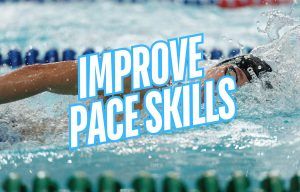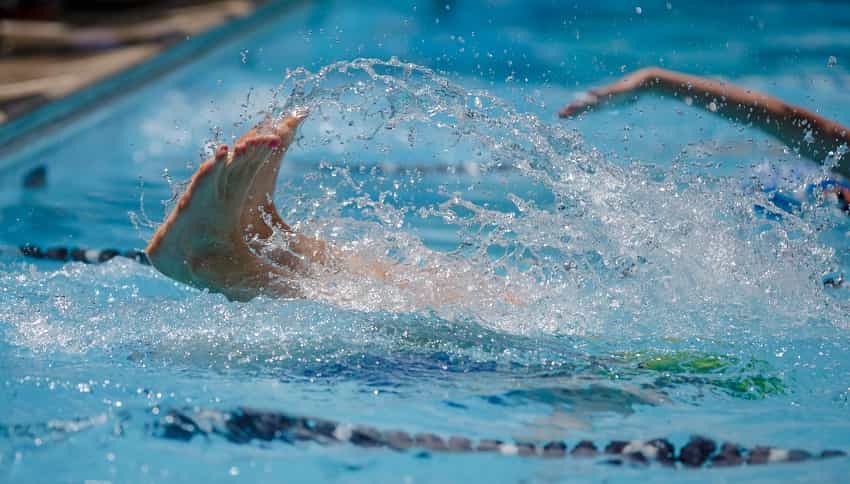
How to Improve Your Pacing Skills
Looking to up your pacing skills in the pool? Here are some actionable pacing tips and tools to help you master pace and your performance on race day.

We all know how critical our turns are—but it’s not just the turn itself that can make a staggering difference to our overall result. The way we swim into the turn matters just as much.
Being the enterprising and curious person that I am I broke down an old 50 freestyle swim from days of yonder.
I was interested in seeing my splits over the course of the race. And after rechecking my math about fifteen times, I came to a surprising realization—the way I was approaching turns was awful.
The last ten meters into the wall was swum at a clip that was 0.2m/seconds slower than at any other point in the race.
Which, the more I thought about it, was completely ridiculous.
After all, from the 15m to 25m we are flying—we are fresh, and we have the speed of a dive and powerful breakout working for us.
So what accounted for the dip in speed?
In looking over the race video it was clear I was picking up my head a bit to see where the wall was. And my stroke rate slowed down as I was measuring out how many strokes I would need to do going into the turn.
In other words, I was stomping on the brakes when I should have been swimming faster than ever, costing me significant time.
“I need to work on my turns,” is something I have heard countless times on deck.
And so we set to trying to rotate our bodies faster. Or getting our feet off the wall a tad quicker.
But developing unbeatable flip turns starts long before you get to the wall.
The slowing down heading into the wall is a common problem with swimmers—even an elite swimmer like 1500m freestyle world record holder Sun Yang performs a series of breathe-every-single-arm-stroke in and out of his turns, softening the momentum he carries in and out of his walls.
And it’s not like we want to slow down.
So what is the deal? Why are we hitting the brakes on our swimming into the turns?
In essence, it’s our survival instincts at work.
Subconsciously, there is a big red light coming up, and it’s got a big old T staring at us.
Our head picks up, we start measuring our strokes, and we tap the brakes on the speed we had going into the wall.
You can see the difference in swimmers who attack the wall, and those who don’t. The former charge into it, while the latter floats into the wall, almost casually.
In order to develop that “attack the walls” mindset there are a couple easy things you can do to improve in practice:
The easiest way to change up the way you approach your walls is to deploy some strategic self-talk during your swim practices and races.
In the last ten meters or yards of each lap throw down some positive and aggressive self-talk to reinforce the outcome you want—a fast, unyielding turn.
The simplest one: “Go, go, go!”
It doesn’t need to something complicated and convoluted—“Now is the time that I desire to escalate my rate of stroke in order to facilitate a more thunderous turn!”
Your trigger words should be nice and simple.
In terms of actual training for faster walls, incorporate more build 25’s and build 50’s in your swimming.
A way to train lazy turns out of your swimming is to focus on having high degrees of effort during that part of each rep. Build 50’s where you sprint 10m in, and 10m out of each wall are one way to do it.
According to Katie Ledecky’s coach Bruce Gemmell, she will finish every hard repeat with escalated effort. This means the final 15y/m of every rep is done with a little more intensity to simulate a racing finish.
This does a couple things—teaches you via the experience of doing it over and over that you always finish like a hero, and it builds the habit of charging into the walls.
Sometimes the big improvements we want in the pool can be found in the silliest of places.
Had I known better at the time, I could have shaved 0.6 seconds off the result from that one swim. And that is with just one turn.
So yes, the details can matter in a big way. The next time you hop into the pool do so with more mindful, aggressive approaches to your turns.
Photo Credit: Dave Dugdale

Olivier Poirier-Leroy Olivier Poirier-Leroy is the founder of YourSwimLog.com. He is an author, former national level swimmer, two-time Olympic Trials qualifier, and swim coach.
✅ Free shipping on Orders over $49
✅ Price Match Guarantee
✅ Best selection of gear for training and competition
✅ Fast and Easy Returns

“This is the best book I have ever seen concerning mental training.” — Ray Benecki, Head Coach, The FISH Swim Team


Looking to up your pacing skills in the pool? Here are some actionable pacing tips and tools to help you master pace and your performance on race day.

Looking for tips on how to use a drag chute for improved swim performances? Read on for some proven tips, sets, and pointers for training with a chute.

Ready to take your swimming to the next level? Here are seven ways that a drag chute can help you become a better and faster swimmer.

Wondering if a swim bench can help improve your swimming? Here are six benefits of swim benches for better technique, more power, and faster swimming.

Not breathing into the walls is one of the fundamental skills developing swimmers are taught. Here is how powerful a no-breath approach is for turn and swim speed. Strong training habits are something swimmers hear a lot about from their earliest days of their competitive swimming careers. The greatest hits

Drills with a swim snorkel are one of the best ways to maximize engagement and skill development. Here are five swim snorkel drills to try for faster swimming.
SITE
SHOP
GUIDES

LANE 6 PUBLISHING LLC © 2012-2025
Join 33,000+ swimmers and swim coaches learning what it takes to swim faster.
Technique tips, training research, mental training skills, and lessons and advice from the best swimmers and coaches on the planet.
No Spam, Ever. Unsubscribe anytime.
